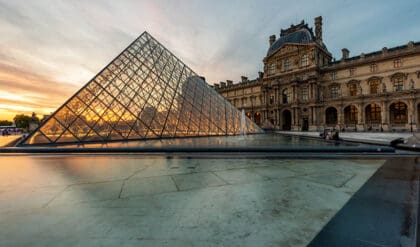Introduction
The Mona Lisa, known as La Joconde in French, stands as a pinnacle of Renaissance art, symbolizing an era of unparalleled creativity and artistic mastery. Created by the legendary Leonardo da Vinci in the 16th century, this enigmatic painting, now housed in the Louvre Museum, Paris, continues to intrigue and inspire millions worldwide.
A Journey from Italy to France: Mona Lisa’s Voyage
Leonardo da Vinci, a polymath of the Italian Renaissance, reportedly brought the Mona Lisa with him when invited to France by King Francis I. Initially part of Leonardo’s private collection, the painting was later integrated into the royal collections of France. The artwork found its permanent home in the Louvre in 1797, transitioning from the palatial walls of Versailles to the public domain.
The Enigmatic Smile: Aesthetics and Technique
The Mona Lisa is celebrated for its innovative composition, resembling contemporary portrait styles. The painting’s most notable feature, Mona Lisa’s elusive smile, has been a subject of artistic study and speculation. This aspect, coupled with the eyes’ placement, creates an illusion of being followed by her gaze. The background, crafted using Leonardo’s sfumato technique, adds depth and mystery, blurring the lines between reality and illusion.
Behind the Portrait of Mona Lisa: Theories and Speculations
The identity of the woman depicted in the Mona Lisa remains a subject of debate. One popular theory suggests she was Lisa Gherardini, the wife of Florentine merchant Francesco del Giocondo, giving the painting its alternate name, La Gioconda. Other hypotheses propose she might be a representation of Giuliano de’ Medici’s lover, adding layers to the painting’s enigma.
Theft and Popularity: A Global Icon
The Mona Lisa gained significant public attention following its theft in 1911. The media frenzy around the theft and the subsequent discovery of the painting elevated its status to a global icon. Vincenzo Peruggia, an Italian patriot, was found guilty of the theft, intending to return the masterpiece to Italy.
Mona Lisa in Pop Culture
The Mona Lisa’s influence extends beyond the art world into popular culture. Marcel Duchamp’s 1919 parody and the success of Dan Brown’s novel, “The Da Vinci Code,” have further cemented the painting’s status in contemporary culture. Its allure continues to draw crowds to the Louvre, making it a symbol of artistic mystique.
Conclusion
The Mona Lisa remains a testament to Leonardo da Vinci’s genius and the enduring appeal of Renaissance art. Its mysterious allure, coupled with a rich historical tapestry, makes it more than just a painting. It’s a cultural phenomenon that continues to captivate the imagination of the world.


